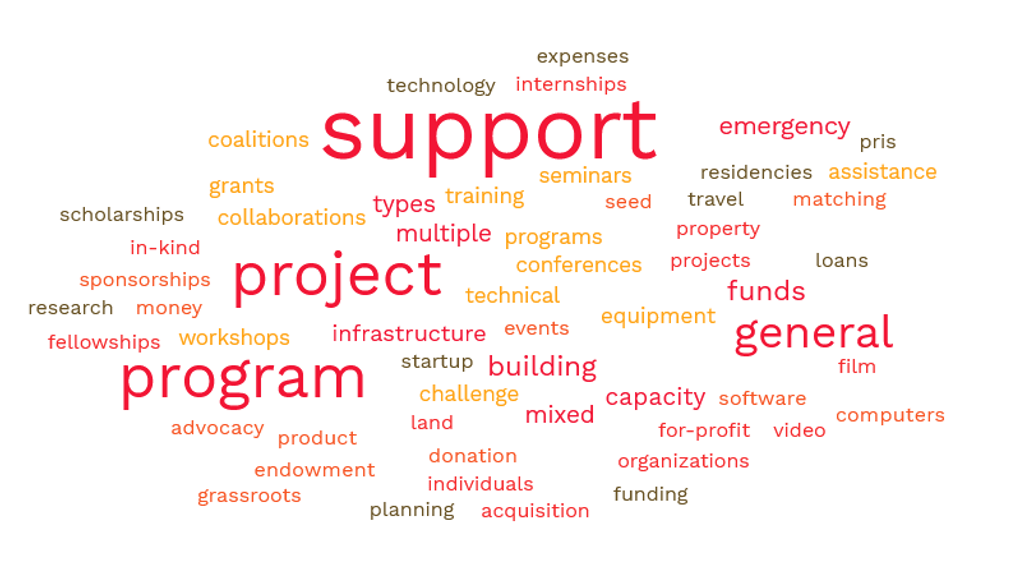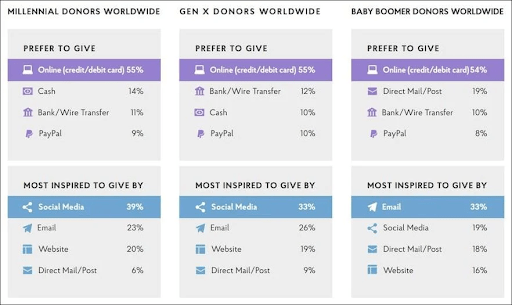
Can the type of support you are requesting, general operating versus special projects for example, affect the outcome of your grant request? Decades of grantmaking reports clearly indicate that funders prefer to invest their support in specific projects or the launch of a new program. This preference has always been contentious. Nonprofit leaders know that to secure grant awards, they need to offer up something special, but that to run or grow their organizations they need general operating or capacity building support. It is a long-standing conundrum that many nonprofit leaders face.
Let’s say a museum asks a grantmaker to fund a new exhibit, but what it truly needs is money to keep the doors open and pay staff decent wages, i.e. money to cover basic general operating costs. Rather than make a request for general operating support, the museum asks the funder to support the exhibit. It does so because it knows that is what the funder will most likely support, and because the new exhibit will bring in more people, resulting in more tickets sold and, therefore, more general operating money. It’s a roundabout way to get the funds needed, but it is a game almost all nonprofits play.
While this is a frequent scenario, things may be set to change. In this article, we will explore types of support other than project or seed funding that are capturing the interest of more grantmakers and that your organization may want to pursue in 2023: general operating, capacity building, advocacy, and capital investment support. (For information on what other types of support there are, review the list of types of support on the GrantStation website.)
General Operating Funds
The havoc the pandemic played on nonprofit organizations all over the world resulted in one positive outcome: Grantmakers actually provided general operating funds for numerous organizations, no strings attached. Many in the philanthropic realm hoped that these one-time awards would result in grantmakers understanding and embracing the importance of this type of support. But as the recovery process began, grantmakers attached specific requirements to these funds, or grantmakers who had made general operating awards started to back away from them. In general, there has been an erosion of general operating support since the worst of the pandemic.
Where does that leave organizations trying to secure general operating grant awards in 2023?
It is important to realize that grantmakers are somewhat confused around providing general operating support as many general operating proposals request both leadership development support, often thought of as capacity building, and organizational support. If you include leadership training in your general operating requests, you need to note that this is part of your ongoing operating expenses, not a special project. This issue is explored more fully in a Chronicle of Philanthropy webinar (no cost): General-Operating Grants Can Advance Equity: A Conversation With Foundation and Nonprofit Leaders.
Another takeaway from this webinar is that, “Family philanthropy is curious about general operating support.” Many family funds provided flexible support during the pandemic, but the reasoning behind that support is gone, and now it comes down to trust: Can these funders trust the organization to continue to invest their support in addressing their overall mission?
Given that trust seems to be a big issue for these family funds, building trust is imperative if an organization wants to continue receiving operating support. And trust equates to honesty, so nonprofits requesting general operating support want to be as forthright and detailed as possible. Don’t sugar coat or hide anything from the potential funder, but rather engage them in both the positive and negative aspects of your organization’s current situation.
Also important to consider in your general operating requests, is that some funders are currently looking at how they can best help organizations to address their missions. Your pitch to these funders has to demonstrate how general support allows your organization to integrate its approach across programs.
There are a couple of other things to keep in mind when developing general operating support requests that could improve their chances of success: One of the disadvantages for grantmakers when it comes to providing operating support is simply that measuring success or outcomes can be difficult. This means you need to clearly demonstrate how you will measure and report on outcomes. On the other hand, the disadvantage of providing project support, for both the grantmaker and the organization, is the sustainability of that project. It’s a big question mark that can be addressed if the funder provides general operating instead of project specific support, and this warrants being called out in your grant request.
Capacity Building Support
Organizational capacity funding has been on the philanthropic radar since the early 2000s. The term was originally used internationally when talking about helping organizations develop but it quickly caught on as funders in the U.S. and Canada saw the value of helping an organization adopt and act on fulfilling their missions.
The percentage of grantmakers supporting capacity building as a distinct “type of support” is still relatively low. However, many grantmakers (about 65% according to a report put out by Grantmakers for Effective Organizations) provide capacity building support but don’t label it as such. They may call it leadership development, evaluation, communications, technology, etc., but in essence it is capacity building.
The concept of capacity building has evolved and, according to a report released by the Hewlett Foundation, How Funders are Strengthening Nonprofit Capacity: Findings from a Field Scan, it is now defined as “the process of building and strengthening the systems, structures, cultures, skills, resources, and power that organizations need to serve their communities.”
This report demonstrates that funders are now aware that there are two types of capacity building: short-term and long-term. Short-term capacity building helps an organization act on their one, two, or even three-year strategic plan, whereas long-term capacity building focuses on “more holistic investments in organizational effectiveness, sustainability, learning, adaptability, well-being, and resilience.” Knowing which type of capacity building the funder you approach is most interested in is critical when making an application for support. If you can’t determine this from their website or past grant awards, then a phone call or email for clarification is in order.
The report also noted an ongoing trend: support for building networks, coalitions, and movements. Incorporating any relationships you have with other organizations, businesses, and government entities into your proposal may be the final ingredient that moves your proposal onto the “to be funded” pile.
As you do your research, you will probably look at organizations the funder has supported in the past, but be careful not to mimic their request. In the area of capacity building, it is important to keep in mind that one shoe doesn’t fit all. Each organization is unique, so the capacity building efforts the grantmaker funded for the last organization probably won’t work for your organization. It is also important when seeking capacity building support that you ask for multi-year funding.
Advocacy Funding
For many years, it was difficult to find grantmakers interested in investing in advocacy work, which includes activities to influence public policy such as lobbying and public education. However, it has taken off in the past three or four years. Funding advocacy work takes two distinct paths: Either the grantmaker funds an organization whose advocacy work falls within their own area of focus, or they fund an advocacy project within an organization whose mission they support.
There has been somewhat of a sea change when it comes to funding advocacy work. Many grantmakers now understand that when it comes to supporting any sort of advocacy there is no “win”; rather, they are looking to determine measurable progress toward solving the problem. This means your grant proposals must truly demonstrate how you will measure and report outcomes. Keep in mind that traditional program evaluation models may not apply when it comes to advocacy work so take some time to develop an evaluation process that reflects the work you’re trying to do. This also means that your proposal should request flexible reporting requirements and timelines, as this kind of social change work can be amorphous.
2020 through 2022 has taught many advocacy groups that unexpected challenges and crises can dramatically impact their work. As you develop your grant requests, be sure to note how the pandemic affected your work, and, as part of your request, ask for funding for the development or implementation of contingency plans for emergencies. Developing specific protocol for continuing to advocate during challenging times should be reflected in most requests to grantmakers asking for advocacy support.
You can read more about funding advocacy work via an article published by the Center for Evaluation Information. Another article, “No Royal Road: Finding and Following the Natural Pathways in Advocacy Evaluation,” provides information that will help you develop your grant request for funding your advocacy work.
Capital Campaigns
Ah, the original spark plug for all fundraising: the capital campaign. Really it is the oldest form of fundraising, going back several centuries when individual leaders asked for donations to build a church or a new theater.
In general, capital campaigns are the same as they have always been: an organized fundraising drive that results in a capital investment, such as a land or building purchase, the renovation or expansion of an existing building, or even a technology upgrade. The typical role of a grantmaker in a capital campaign is to provide challenge grants or matching funds. That aspect of running a campaign hasn’t changed much. The new element is technology.
Over the past three to five years, technology has played a role in changing how capital funds are raised. For example, printed materials were the foundation of these campaigns for decades. Now, however, more and more fundraisers use online materials, which are less expensive, less damaging to the planet, and easier to circulate. This new approach opens the door to asking funders to invest in your campaign up front to help you set the stage for a successful campaign.
Also, most capital campaigns focus on individual donors, and it is much easier to recruit these individual donors via online solicitation. The chart below, published by Nonprofit Tech for Good in their 2020 Global Trends in Giving Report, demonstrates that individuals, regardless of their age, prefer to give online. It also indicates that email and social media, versus direct mail and websites, are most important in inspiring giving across all age groups. This is all information you can use in your grant requests and in developing your campaign for fundraising from individuals. (This type of data might especially resonate well with corporate funders.)

While technology may have changed how capital campaign fundraising is conducted, it has also opened the door for initial requests to grantmakers.
To get an overall sense of how to position your capital campaign in 2023, read Classy’s “Capital Campaigns: Trends and Tips You Need to Know.”
Final Thoughts
Including the four types of support explored here—general operating, capacity building, advocacy, and capital—GrantStation identifies over 30 different types of support grantmakers offer. Reviewing the definitions on the GrantStation website may trigger some new ideas for undertaking your grant research in 2023 and beyond.
And, finally, when you undertake research to identify funder(s) for your organization, remember that combining a type of support with your mission focus, or a specific area of interest, will allow you to find the most appropriate funders for your organization, programs, and projects.